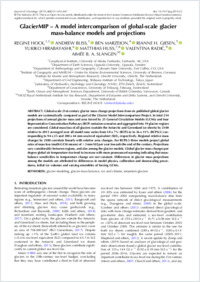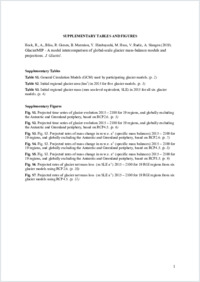GlacierMIP – A model intercomparison of global-scale glacier mass-balance models and projections
- Hock, Regine Geophysical Institute, University of Alaska Fairbanks, Fairbanks, AK, USA - Department of Earth Sciences, Uppsala University, Uppsala, Sweden
- Bliss, Andrew Department of Anthropology and Geography, Colorado State University, Fort Collins, CO, USA
- Marzeion, Ben Institute of Geography and MARUM – Center for Marine Environmental Sciences, University of Bremen, Germany
- Giesen, Rianne H. Institute for Marine and Atmospheric Research, Utrecht University, Utrecht, The Netherlands
- Hirabayashi, Yukiko Department of Civil Engineering, Shibaura Institute of Technology, Tokyo, Japan
- Huss, Matthias Laboratory of Hydraulics, Hydrology and Glaciology (VAW), ETH Zürich, Zürich, Switzerland - Department of Geosciences, University of Fribourg, Fribourg, Switzerland
- Radić, Valentina Earth, Ocean and Atmospheric Sciences Department, University of British Columbia, Vancouver, Canada
- Slangen, Aimée B. A. NIOZ Royal Netherlands Institute for Sea Research, Department of Estuarine and Delta Systems, and Utrecht University
-
2019
Published in:
- Journal of Glaciology. - 2019, vol. 65, no. 251, p. 453–467
English
Global-scale 21st-century glacier mass change projections from six published global glacier models are systematically compared as part of the Glacier Model Intercomparison Project. In total 214 projections of annual glacier mass and area forced by 25 General Circulation Models (GCMs) and four Representative Concentration Pathways (RCP) emission scenarios and aggregated into 19 glacier regions are considered. Global mass loss of all glaciers (outside the Antarctic and Greenland ice sheets) by 2100 relative to 2015 averaged over all model runs varies from 18 ± 7% (RCP2.6) to 36 ± 11% (RCP8.5) corresponding to 94 ± 25 and 200 ± 44 mm sea-level equivalent (SLE), respectively. Regional relative mass changes by 2100 correlate linearly with relative area changes. For RCP8.5 three models project global rates of mass loss (multi-GCM means) of >3 mm SLE per year towards the end of the century. Projections vary considerably between regions, and also among the glacier models. Global glacier mass changes per degree global air temperature rise tend to increase with more pronounced warming indicating that mass-balance sensitivities to temperature change are not constant. Differences in glacier mass projections among the models are attributed to differences in model physics, calibration and downscaling procedures, initial ice volumes and varying ensembles of forcing GCMs.
- Faculty
- Faculté des sciences et de médecine
- Department
- Département de Géosciences
- Language
-
- English
- Classification
- Hydrology
- License
- License undefined
- Identifiers
-
- RERO DOC 326749
- DOI 10.1017/jog.2019.22
- Persistent URL
- https://folia.unifr.ch/unifr/documents/307948
Other files
Statistics
Document views: 97
File downloads:
- hus_gmm.pdf: 255
- hus_gmm_sm.pdf: 150

